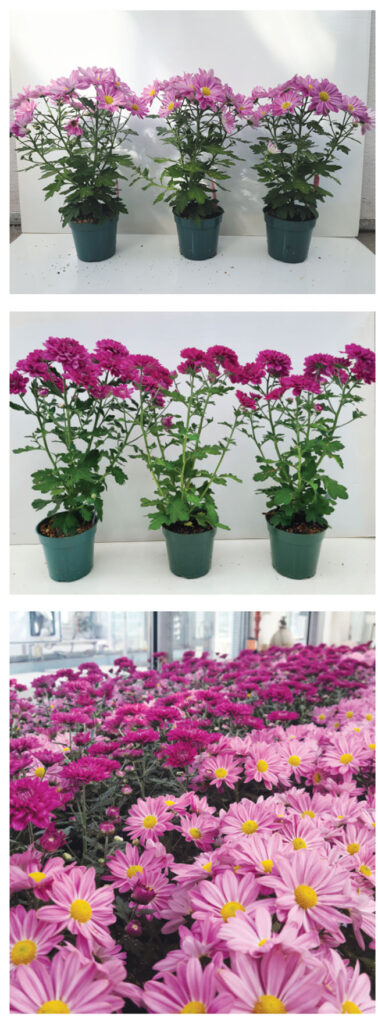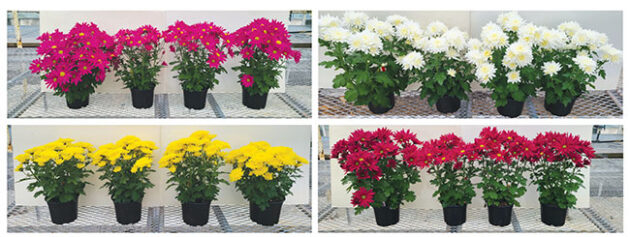
Features
Reducing nutrient inputs in mums
Modified strategy reduces costs, improves plant health
October 6, 2023 By DR. BARRY J. SHELP, KATHERINE TEETER-WOOD, EDWARD J. FLAHERTY, LOU M. SCHENCK, AND JAMIE ALBERS
 Market-quality ‘Milton Dark Pink’ (top panel) and ‘Williamsburg Purple’ (middle panel) chrysanthemums were produced across the different nutrient regimens in a research setting.
PHOTOS: Dr. Barry Shelp et al.
Market-quality ‘Milton Dark Pink’ (top panel) and ‘Williamsburg Purple’ (middle panel) chrysanthemums were produced across the different nutrient regimens in a research setting.
PHOTOS: Dr. Barry Shelp et al. Chrysanthemums are an economically important floricultural crop worldwide. In Canada alone, approximately five-million indoor potted chrysanthemums were grown in 2020, making it the third most produced flower in the country. Indoor potted chrysanthemums are an excellent model ornamental crop for studying nutrient delivery because they are widely grown with closed sub-irrigation and drip-irrigation systems, which allow the recycling and reuse of nutrient-rich solution.
WHY WAS THIS STUDY CONDUCTED?
Plant growth increases with increasing tissue nutrient concentration until maximum growth is reached. At maximum growth, tissues can accumulate more nutrients and store them for future remobilization, but plant growth remains constant in this nutrient sufficiency zone. The sufficiency zone is large, so that the standard practice is to provide fertilizers so that the tissue nutrient concentration is in the upper range of this zone, which exceeds their requirements.
Many commercial fertilizer formulations (e.g., Peter’s Professional Peat-Lite Neutral Cal-Mag 17−3−17, ICL Fertilizers; Fusion Plant-Prod 17−5−17, Master Plant-Prod) are available for chrysanthemum production. They have similar macronutrient and micronutrient composition (in ppm): 285−300 N, nitrogen; 53−84 P, phosphorus; 285−300 K, potassium; 48–72 Ca, calcium; 17–22 Mg, magnesium; no S, sulphur; 0.75−0.83 Zn, zinc; 0.36−0.83 Cu, copper; 0.75−0.83 Mn, manganese; 0.1.50−1.68 Fe, iron; 0.34−0.36 B, boron; and, 0.15−0.26 Mo, molybdenum.
Previously, our research group demonstrated that the supply of NPK to modern cultivars of indoor potted chrysanthemums can be reduced by approximately 75 per cent during the vegetative stage, compared to the commercial fertilizers, without compromising quality, and that it can be removed completely during the flowering stage. We also demonstrated that levels of the individual micronutrients can be similarly reduced. To validate this work, two similar experiments were conducted in a research setting using sub-irrigation and simultaneous reductions in essential macronutrients and micronutrients over the low sufficiency range during vegetative growth. Also, one experiment was conducted in a commercial setting using drip-irrigation.
WHAT ARE THE KEY FINDINGS?
The sub-irrigation experiments were replicated in a naturally lit research greenhouse during the summer 2022 and the summer/fall 2022 seasons using two cultivars (one cutting per 10 cm dia. pot). Nutrients were supplied to the 50:50 peat/perlite-based pot mixture via the use of a commercial peat Jiffy plug amended with 30 per cent minerals of unknown composition (Model CF Hort. Plug 343040, Jiffy Products (N.B.) Ltd., Shippagan, NB, Canada); pH adjustment added Mg and Ca. Three rates of soluble nutrients were supplied during vegetative growth only, ranging from (in ppm): 75–150 N, 23–47 P, 103–205, 78–156 Ca, 11–21 Mg, 7–14 S, 0.15–0.29 Fe, 0.07–0.11 Mn, 0.06–0.11 Zn, 0.01–0.02 Cu, 0.01–0.03 B, and 0.01–0.02 Mo). Similar results were found with the cultivars ‘Milton Dark Pink’ and ‘Williamsburg Purple’ (Fig. 1). Results showed that the entire nutrient suite could be reduced during the vegetative stage by approximately 75 per cent, compared to commercial fertilizers, without any visible signs of nutrient deficiency. Furthermore, plant growth and quality were not substantially affected.
There were slight reductions in diagnostic leaf N (4−8 per cent), and as much as 20−23 per cent, 30 per cent and 40 per cent reductions in leaf B, Mn and Cu, respectively, across the two cultivars with decreasing nutrient supply in experiment 1, but no changes in these leaf nutrients in experiment 2. The leaf Mo increased by 30−40 per cent with decreasing supply in experiment 1 but was unaffected in experiment 2.
A single drip-irrigation experiment (experiment 3) was conducted in a commercial setting in the fall season 2022 using four cultivars (three cuttings per 15 cm diameter pot). Several nutrients (N, P, K, Ca, Mg, S, Fe) were added directly to the 90:10 peat/perlite-based pot mixture by a combination of custom nutrient pre-mixes and pH adjustment. Also, soluble nutrients were supplied over the low sufficiency range during vegetative growth only. A commercial fertilizer source with separate pre-mixed macro- and micro-nutrient bags was used so the exact mixture could not be as closely controlled as with the sub-irrigation experiments described above, resulting in similar N, P and K supplies, lower Mg and Ca supplies, and higher supplies of the micronutrients than in the sub-irrigation experiment. Sulphur was supplied directly to the pot medium only. The supply of soluble nutrients ranged from (ppm): 75–150 N, 22–44 P, 75–150 K, 13–26 Ca, 5–9 Mg, 0 S, 0.21–0.85 Fe, 0.11–0.43 Mn, 0.11–0.43 Zn, 0.11–0.43 Cu, 0.05–0.18 B, and 0.03–0.13 Mo). None of the cultivars (‘Milton Dark Pink’, ‘Springdale Purple’, ‘Olympia White’ and ‘Covington Yellow’) exhibited signs of nutrient deficiency or a consistent decreasing trend in shoot yield across the treatment range (Fig. 2).
Total dissolved solids and electrical conductivity in the pot leachate was reduced from 1516 to 361 ppm and from 3022 to 738 µS cm1, respectively with the decreasing nutrient supply. Replacement of the nutrient solutions with potable water decreased these levels within days to those present in the water.
Across cultivars, maximal losses in tissue N, P, K, Mo, Cu and Mn of the diagnostic leaf in response to the treatments were 18−23 per cent, 46–60 per cent, 32–36 per cent, 33–72 per cent, 33–42 per cent, and 35–44 per cent, respectively. The other nutrients did not exhibit obvious decreases in tissue levels with decreasing nutrient supplies.
Across all cultivars, treatments and experiments, the leaf nutrient levels were: 4.91−6.60per cent DM N, 0.41−1.06 per cent DM P, 4.26−7.32 per cent K, 0.93−1.58 per cent DM Ca, 0.38−0.69 per cent DM Mg, 0.30−0.43 per cent DM S, 78−175 ppm Fe, 35−280 ppm Mn, 28−69 ppm Zn, 2.0−16 ppm Cu, 27−55 ppm B, and 0.5−22.8 ppm Mo. The nutrient levels in these three experiments generally aligned with established sufficiency levels provided by the Ontario Ministry of Agriculture, Food and Rural Affairs, (OMAFRA) in Publication 350 for chrysanthemum (4−6 per cent DM N, 0.2−1.2 per cent DM P, 1−10 per cent DM K, 0.5−4.6 per cent DM Ca, 0.1−1.5 per cent DM Mg, 20–750 ppm Fe, 25–375 ppm Mn, 5−35 ppm Zn, 5−50 ppm Cu, and 20−200 ppm B. Tissue sufficiency levels in the scientific literature for S and Mo in dicotyledonous plants are 0.25−0.70 per cent DM and 0.1–1.0 ppm, respectively. Copper could be described as marginal in some cases, though Cu deficiency symptoms were not observed. Thus, the low nutrient inputs provided were sufficient to sustain maximal plant growth and could be considered to be in the low sufficiency zone, rather than in the deficiency zone.

FIGURE 2
Market-quality ‘Milton Dark Pink’, ‘Olympic White’, Covington Yellow’, and Springdale Purple’ (from top to bottom rows) were produced across different nutrient regimens in a commercial setting.
IMPLICATIONS OF THESE FINDINGS FOR YOUR FARM OPERATION
Our modified nutrient delivery strategy was fully tested and validated with contrasting cultivars of chrysanthemum using both sub-irrigation and drip-irrigation. The nutrient supply was interrupted at bud break, and the macronutrient and micronutrient supplies were reduced by 77–82 per cent and 91–99 per cent, respectively, during vegetative growth, compared to common fertilizer formulations, without adversely affecting tissue nutrient levels and plant/flower quality. These findings suggest that none of the low nutrient regimens employed here limited growth processes. Thus, the common practice of delivering superfluous nutrient levels to greenhouse-grown chrysanthemum crops has little scientific merit. Furthermore, salt accumulation in the pot medium of drip-irrigated plants was reduced by decreasing nutrient supplies. In closed drip-irrigation systems, plants are typically over-irrigated by 25−45 per cent to prevent salt accumulation, but optimizing nutrient delivery would minimize the need for over-irrigation and subsequent adjustment of the nutrient solution.
Adoption of our modified delivery strategy would reduce nutrient usage and production costs, the volume and nutrient level of the feedwater for treatment and/or approved discharge, and risks of salt damage to the crop and contamination of local waterways. Growers could consider reducing the amount of fertilizer applied to indoor potted chrysanthemum crops grown with sub-irrigation or drip-irrigation.
Barry Shelp is professor emeritus, and Katherine Teeter-Wood and Edward Flaherty are graduate students in the Department of Plant Agriculture at the University of Guelph. Lou Schenck is owner and operator of, and Jamie Aalbers is the trial manager at Schenck Farms and Greenhouses. For more information, please contact Dr. Shelp at 519-824-4120 ext. 53089, or bshelp@uoguelph.ca.
Print this page